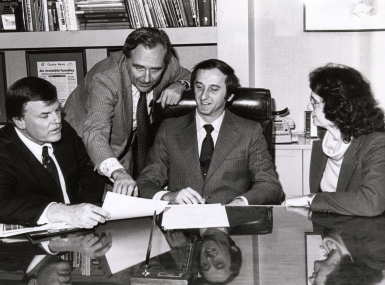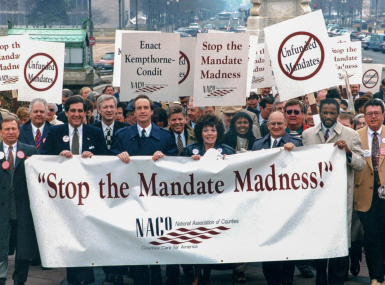Lights. Leadership. Action! - NACo's Annual Conference Report
Upcoming Events
Related News
Lights! Action! Leadership!
Welcome to NACo’s 2016 Annual Conference in Long Beach, Calif. in the heart of L.A. County. The conference started with a bang July 22 with the first-ever Opening Annual Conference Reception on the plaza outside the Long Beach Performing Arts Center.
The event capped a busy day of policy committee meetings, a well-attended luncheon-discussion on the opioid crisis and Technology Summit wrap-up sessions. NACo’s 10 policy committees discussed, debated and adopted dozens of proposed platform changes and new policy positions which will be placed before NACo members for a vote at the Annual Business Meeting, July 25.
Read about the day’s highlights.
Opioid Luncheon
The opioid medication and heroin abuse epidemic has reached nearly every county in the United States, and as Sam Quinones tells it in Dreamland: The True Tail of America’s Opiate Epidemic, it was the convergence of two independent trends that met in the late 1990s.
The first was the rise of black tar heroin trafficking from Mexico starting in the 80s, as an increasingly corporatized trafficking operation spread eastward, without the accompanying violence characteristic of the urban heroin scene.
“They were delivering heroin like a pizza franchises,” he told the luncheon audience. “They stressed customer service and went where there wasn’t any competition. And they offered a product that was more pure than what was coming from Burma or Turkey.”
Meanwhile, a dramatic change in medical philosophy about using opioid painkillers for all manner of ill coincided with a pharmaceutical push to prescribe Oxycodone, which is molecularly similar to morphine and heroin.
“A 101-word letter to the editor in the New England Journal of Medicine became the cornerstone, used as evidence to convince doctors that you could prescribe these pills for anything,” Quinones said. “The new addicts were either following the doctor’s orders or getting into it recreationally. The pills take the tolerance to new heights, but then they can’t afford it so they switch to cheap heroin.
“It was, a new kind of drug trafficking meets a new type of drug promotion.”
Although the scourge has changed economies, taken lives and ruined others, Quinones and many of the people he talked to saw hope in the potential for a change in the criminal justice system, now that there is political pressure on the epidemic.
“If we’re not going to arrest our way out of this, we have to find more treatment beds,” he said. ”Jail is the place to make this difference. You have people detoxing and thinking clearly for the first time in years and the realize they want to make a change in their lives. Right now, this is when we push them into a predatory, boring, non-productive system and instead we could treat and rehabilitate people who wind up in jail.
“The infrastructure is there, because it’s more expensive to build a jail and put in the plumbing than to do the programming to make this possible.
“If that’s the legacy of this epidemic, we may actually thank heroin someday.”
Day 2 - July 22
More meetings, the NextGen Community Service Project and the Opening General Session highlighted the formal opening of the conference. The NextGen Community Service Project supported the work of Project Innocence, a L.A. county-based non-profit devoted to rescuing and restoring child victims of sex trafficking. Volunteers packed 150 backpacks with clothing, shoes, tablets, blankets and toiletries, Chris Lim, Saving Innocence director of partnerships, told the volunteers they were filling the packs “with hope, peace and protection.”
The Opening General Session featured all-time basketball great, Kareem Abdul-Jabbar and GIS guru and entrepreneur Jack Dangermond, founder and president of world’s fourth largest GIS company. The session also marked the launch of a new NACo strategic partnership, USPERS.
Dangermond, touted the benefits of linking data with geography to identify and help find solutions to perplexing and threatening world problems such as climate change and habitat destruction. GIS, with its geography-based data layers provides a fresh way at seeing and understanding problems.
Interviewed by L.A. County Supervisor Don Knabe, Jabbar talked about his heroes, short movie career and offered thoughts on racism and policing. Afterwards, he signed copies of his latest book, Writings on the Wall: Searching for a New Equality Beyond Black and White
The session also marked the launch of a new NACo strategic partnership, US PERS -- the United States Public Employee Resource Solution. US PERS will offer retiree health care solutions.
Read more about the day’s top features.
Jack Dangermond
ESRI president and co-founder Jack Dangermond showed assorted county officials at the Opening General Session what was possible with geographic information systems.
The software he pioneered is now at work in many departments in counties across the nation, with applications ranging from real estate assessment databases to emergency management. “Mapping and GIS technology is becoming a kind of language that is essential for managing in a digital environment,” he said. “It’s a visual language that helps us look at and see instantly understand things that we couldn’t understand with all of the written words and mathematical languages. This is a language for everybody -- it touches everything.”
Throughout, Dangermond illustrated the impact geography, what he called “the platform or understanding and acting,” has on management.
“GIS is affecting the whole process of planning in economic development, from green infrastructure planning to urban design in terms of understanding before acting.”
He showed off how weather information can be adapted through GIS maps to predict how the rainfall will eventually flow downstream, and warnings for earthquakes hundreds miles away that could give people a chance to get to safety before the shocks reach them.
“Counties are using it in different departments to save money, save time, be better, but the holistic aspect is something I particularly think you as elected officials need to know and understand, it’s right there to be captured and used.”
“We create geographic knowledge, understand it and then act in a more sensible way.”
Dangermond described the future of what was possible with GIS, as it is integrated into various new and existing technologies, including dynamic data.
“The world is becoming real time in digital space,” he said.
“You and I are living in an interesting time because everything is digital even though many of us claim we are not technical,” he said. “Underneath your feet, we’re learning how to measure everything that moves and changes.
Kareem Abdul-Jabbar
A true Renaissance man, basketball legend Kareem Abdul-Jabbar was the main attraction at the Opening General Session.
In his typical quiet, thoughtful manner, he held forth for the better part of a half-hour, taking questions from Los Angeles County Supervisor Don Knabe and left time to answer several questions from the audience.
Abdul-Jabbar, the highest scoring player in NBA history, shared his thoughts on race relations, which he also explores in his latest book, Writings on the Wall: Searching for a New Equality Beyond Black and White.
“Why write this book now?” Knabe asked. “I think I’ve been motivated to write on these subjects my whole life,” Abdul-Jabbar said. “I paid of lot of attention to to the civil rights movement when I was growing up in the `50s and `60s.”
Hearing of the murder of Emmett Till in Mississippi “really got to me,” he said. The turbulent times made him concerned for his own safety.
“The fact that attitudes that had been around for over 100 years really had a lot to do with that,” he said. “It made me very aware of what we need to do in order to communicate with each other and do a better job of making this a great nation for all of our citizens.”
Harking back to his playing days, Abdul-Jabbar fielded several questions from the audience about his college and pro basketball careers.
Knabe also mentioned that Abdul-Jabbar has been nominated for a Presidential Medal of Freedom, and has been asked to speak at the Democratic National Convention.
In closing, Knabe asked Abdul-Jabbar about his Skyhook Foundation, whose mission is to bring educational opportunities to underserved communities. It’s mission: “Give a kids a shot that can’t be blocked.”
Attachments
Related News

Tumultuous ’80s test NACo’s fundamentals
NACo took two entrepreneurial risks in the 1980s — one nearly bankrupted the organization and the other has gone on to pay dividends for more than 40 years.

NACo Board approves new outreach campaign, new affiliate
NACo will launch a public awareness campaign in 2026 promoting the role of county governments to federal policymakers.
